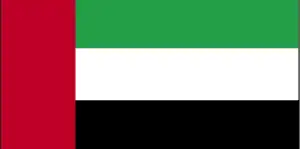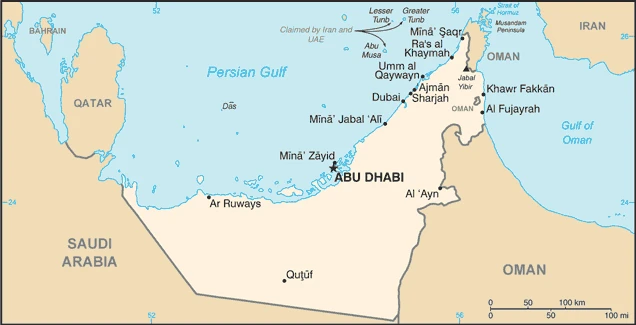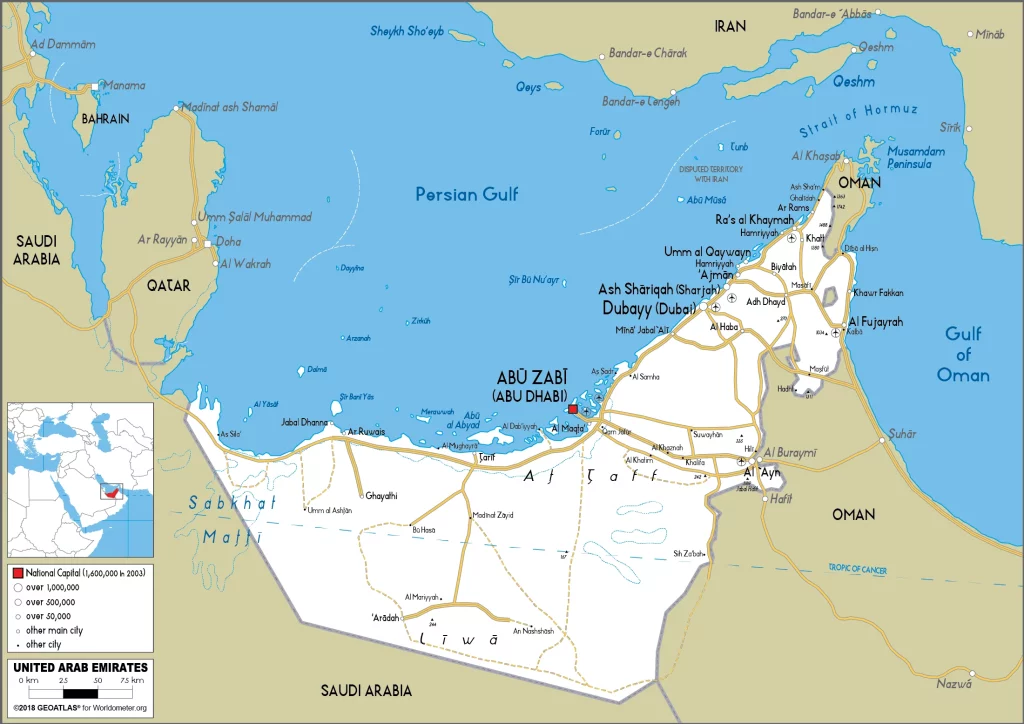United Arab Emirates Google Maps is a site/tool that offers a wide range of map views (topographic, satellite, street view) and navigation options, with little effort on your part, yet efficiently. If you need to plan a trip to a new place like the United Arab Emirates, Google maps are available on desktop, mobile, or tablet. This Google maps and information page is dedicated to the United Arab Emirates, Middle East (19 countries), showing its location, country facts, details about its capital city Abu Dhabi, bordering countries like Oman, Saudi Arabia, and plenty of other information which may be interesting when you visit this Middle Eastern state.
Quick links: Google Maps United Arab Emirates, Abu Dhabi Google maps, Driving Directions United Arab Emirates, Printable Road Map.

About the United Arab Emirates in a nutshell
- Conventional short form of the name: none
- The conventional long form of the name: United Arab Emirates
- Local long form: Al Imarat al Arabiyah al Muttahidah
- Local short form: none
- Former name(s): Trucial Oman, Trucial States
- Etymology: self-descriptive country name; the name Arabia can be traced back many centuries B.C.; the ancient Egyptians referred to the region as Ar Rabi; emirates derives from amir, the Arabic word for the commander, lord, or prince.
- The legal system in the United Arab Emirates is a mixed legal system of Islamic (sharia) law and civil law.
- Climate: Summers are humid, despite minimal rainfall. Sand-laden shamal winds blow in winter and spring.
- The national symbols are golden falcon; national colors: green, white, black, and red.
- Internet TLD: .ae
The United Arab Emirates was created in 1971 from a federation of seven sovereign sheikhdoms. The UAE is the most easily visited region by tourists, with the most hotels, the largest market, bazaar, and the best-developed tourism infrastructure – and only during Ramadan is alcohol consumption restricted. The Qatar Peninsula is not even depicted on 19th-century maps of Arabia. The emirate only opened its doors to tourism in 1989. Massive construction projects are underway everywhere. Even in the second half of the 20th century, during the Suez crisis, the Gulf states showed that they could react almost immediately to world political crises that posed economic obstacles: in almost a matter of days, huge jetties were built, stretching for kilometers into the Gulf and visible from space, to allow giant oil tankers to dock. And today, in Dubai in the Emirates, home to the world’s only seven-star hotel, among other things, a residential area is being built not in the desert but on the water, 15 kilometers into the bay, shaped like a date palm and the world map, serving the elite, both foreign and domestic. And if you’re a fan of winter sports, you’ll also find an ice rink and a snowy ski slope.
In Dubai, Mina Jabal Ali is the largest man-made port globally.
Background
The Trucial States of the Persian Gulf coast granted the UK control of their defense and foreign affairs in 19th-century treaties. In 1971, six of these states – Abu Dhabi, Ajman, Al Fujayrah, Ash Shariqah, Dubayy, and Umm al Qaywayn – merged to form the United Arab Emirates (UAE). They were joined in 1972 by Ras al Khaymah. The UAE’s per capita GDP is on par with leading West European nations. For more than three decades, oil and global finance drove the UAE’s economy. In 2008-09, falling oil prices, collapsing real estate prices, and the international banking crisis hit the UAE. The UAE did not experience the Arab Spring unrest seen elsewhere in the Middle East in 2010-11, partly because of the government’s multi-year, $1.6-billion infrastructure investment plan for the poorer northern emirates and its aggressive pursuit of advocates of political reform. The UAE, in recent years, has played a growing role in regional affairs. In addition to donating billions of dollars in economic aid to help stabilize Egypt, the UAE was one of the first countries to join the Defeat-ISIS coalition and participate as a critical partner in a Saudi-led military campaign in Yemen. On 15 September 2020, the UAE and Bahrain signed a peace agreement (the Abraham Accords) with Israel brokered by the US in Washington DC. The UAE and Bahrain thus became the third and fourth Middle Eastern countries, along with Egypt and Jordan, to recognize Israel.
Geography
Primarily flat, semiarid desert with dunes, salt pans, and occasional oases. Extensive irrigation systems water cities.

Bordering the Gulf on the northern coast of the Arabian Peninsula, the seven states of the UAE are Abu Dhabi, Dubai, Sharjah, Ajman, Umm al Qaywayn, Ras al Khaymah, and Fujayrah.
This state is located in the Middle East, bordering the Gulf of Oman and the Persian Gulf, between Oman and Saudi Arabia, under 24 00 N, 54 00 E coordinates, covering an area of 83,600 sq km with a coastline of 1,318 km. The United Arab Emirates is Slightly larger than South Carolina; slightly smaller than Maine.
The United Arab Emirates has 1,066 km of land boundaries and borders with (2 nations): Oman, 609 km, and Saudi Arabia, 457 km.
Flat, barren coastal plain merging into rolling dunes of a vast desert, mountains in the east, with Jabal Yibir 1,527 m as the highest point of United Arab Emirates, while Persian Gulf 0 m as the lowest point, causing a mean elevation at 149 m throughout the country. With 83,600 sq km, United Arab Emirates has 83,600 sq km of land and 0 sq km of water surface area.
Strategic location and southern approaches to Strait of Hormuz, a vital transit point for world crude oil.
The climate in the United Arab Emirates is as follows: Desert, cooler in eastern mountains.
When you visit the United Arab Emirates, the natural hazards shall be considered: Frequent sand and dust storms.
The following major health-threatening issues shall be considered when visiting United Arab Emirates: none.
Current environmental issues affecting the Emirati people: air pollution, rapid population growth, and high energy demand contribute to water scarcity; lack of natural freshwater resources compensated by desalination plants; land degradation and desertification; waste generation, and beach pollution from oil spills.
Google Maps United Arab Emirates
The capital and other divisions
Capital city: Abu Dhabi found under the coordinates 24 28 N, 54 22 E, applying the time zone UTC+4 (9 hours ahead of Washington, DC, during Standard Time), using the following daylight saving time: none.
Abu Dhabi is the capital of the United Arab Emirates. Abu Dhabi has invested in technology to avoid its carbon footprint and become more environmentally friendly as an oil-rich city. In 2010, it was one of the first cities to introduce electric cars. Abu Dhabi is home to much of the country’s industry and commerce and serves as the seat of government.
United Arab Emirates became independent on 2 December 1971 (from the UK), and its national holiday is Independence Day (National Day), 2 December (1971).
Administrative divisions: 7 emirates (imarat, singular – imarah); Abu Zaby (Abu Dhabi), Ajman, Al Fujayrah, Ash Shariqah (Sharjah), Dubayy (Dubai), Ras al Khaymah, Umm al Qaywayn.
People and society
Emirians, who make up just a quarter of the population, are mostly Sunni Muslims of Bedouin descent and primarily city dwellers. In theory, women enjoy equal rights with men. Poverty is rare, and there is no income tax. The 1970s oil boom encouraged the immigration of workers, mainly from Asia. Western expatriates are permitted a virtually free lifestyle. Islamism, however, is a growing force among the young.
The population in the United Arab Emirates is 9,856,612 (July 2021 estimate). Note: the UN estimated the country’s total population was 9,771,000 as of mid-year 2019; immigrants make up 87.9% of the total population, according to UN data (2019), with an average of 0.62% (2021 estimate) change. That means the United Arab Emirates is the No. 92 in the world’s populated rank list. With an average of 38.4 years median age (40.4 years for males and 40.4 years for women), United Arab Emirates ranks No. 63 on the globe’s median age rank list.
The people living in this country are the Emirati(s) (noun) or Emirati (adjective) and belong mainly to the following ethnic groups: Emirati 11.6%, South Asian 59.4% (includes Indian 38.2%, Bangladeshi 9.5%, Pakistani 9.4%, other 2.3%), Egyptian 10.2%, Filipino 6.1%, other 12.8% (2015 estimate).
They speak Arabic (official language), English, Hindi, Malayalam, Urdu, Pashto, Tagalog, and Persian languages and practice the following religions: Muslim (official) 76%, Christian 9%, other (primarily Hindu and Buddhist, less than 5% of the population consists of Parsi, Bahai, Druze, Sikh, Ahmadi, Ismaili, Dawoodi Bohra Muslim, and Jewish) 15% (2005 estimate), note: data represent the total population; as of 2019, immigrants make up about 87.9% of the total population, according to UN data.
We can conclude the following about the population in the United Arab Emirates: The population is heavily concentrated to the northeast on the Musandam peninsula. The three largest emirates – Abu Dhabi, Dubai, and Sharjah – are home to nearly 85% of the population. In the United Arab Emirates, we are talking about 87.3% (2021) of the total population live in cities, and most of them reside in the following municipalities: 2.921 million, Dubai, 1.737 million, Sharjah, 1.512 million, Abu Dhabi (capital city) (2021).
Industry
Major oil and natural gas exporter; plentiful reserves. Dynamic Dubai: free trade zone, a financial center (but the 2008 global downturn caught overextended banks). Water is scarce. Imports most food. Some emirates are less developed.
The UAE has an open economy with a high per capita income and a sizable annual trade surplus. Successful efforts at economic diversification have reduced the portion of GDP from the oil and gas sector to 30%. Since discovering oil in the UAE nearly 60 years ago, the country has undergone a profound transformation from an impoverished region of small desert principalities to a modern state with a high standard of living. The government has increased spending on job creation and infrastructure expansion, opening up utilities to greater private sector involvement. The country’s free trade zones – offering 100% foreign ownership and zero taxes – are helping to attract foreign investors., The global financial crisis of 2008-09, tight international credit, and deflated asset prices constricted the economy in 2009. UAE authorities tried to blunt the crisis by increasing spending and boosting liquidity in the banking sector. The crisis hit Dubai hardest, as it was heavily exposed to depressed real estate prices. Dubai lacked sufficient cash to meet its debt obligations, prompting global concern about its solvency. Ultimately, a $20 billion bailout from the UAE Central Bank and Abu Dhabi Government was refinanced in March 2014. The UAE’s dependence on oil is a significant long-term challenge, although the UAE is one of the most diversified countries in the Gulf Cooperation Council. Low oil prices have prompted the UAE to cut expenditures, including some social programs, but the UAE has sufficient assets in its sovereign investment funds to cover its deficits. The government reduced fuel subsidies in August 2015 and introduced excise taxes (50% on sweetened carbonated beverages and 100% on energy drinks and tobacco) in October 2017. A five-percent value-added tax was introduced in January 2018. The UAE’s strategic plan for the next few years focuses on economic diversification, promoting the UAE as a global trade and tourism hub, developing industry, and creating more job opportunities for nationals through improved education and increased private sector employment.
The United Arab Emirates is rich in the following natural resources: Petroleum and natural gas.
The main industrial sectors are petroleum and petrochemicals, fishing, aluminum, cement, fertilizer, commercial ship repair, construction materials, handicrafts, and textiles.
The country’s export sectors are robust in crude petroleum, refined petroleum, gold, jewelry, and broadcasting equipment (2019), partnering with these nations: India 11%, Japan 10%, Saudi Arabia 7%, Switzerland 6%, China 6%, Iraq 6% (2019). The export trade resulted in $308.5 billion. Note: Data are in current year dollars (2017 estimate). In a global rank of the export, values resulted in the United Arab Emirates’s position of 22.
Land use in United Arab Emirates: 3.8% (2018 estimate) forest, 91.6% (2018 estimate) other.
The arable land area is 0.5% (2018 estimate), and the agricultural land is 4.6% (2018 estimate). Land use for permanent crops 0.5% (2018 estimate), permanent pasture 3.6% (2018 estimate). The sum of the area of the irrigated land is 923 sq km (2012).
The main agro-industrial products of the United Arab Emirates are dates, cucumbers, tomatoes, goat meat, eggs, milk, poultry, carrots/turnips, goat milk, and milk.
The country typically needs to import: gold, broadcasting equipment, jewelry, refined petroleum, and diamonds (2019), partnering with the following nations: China 15%, India 12%, United States 7% (2019) in a sum value of $229.2 billion (2017 estimate) $226.5 billion (2016 estimate). This sum value on the global ranking list of imports resulted in United Arab Emirates 26.
The United Arab Emirates Driving Directions
In this post, you learned about the United Arab Emirates, Middle East, bordering the Gulf of Oman and the Persian Gulf, between Oman and Saudi Arabia. We published some basic information about its capital Abu Dhabi, and the Emirati nation.
Are you interested in visiting the United Arab Emirates and looking for driving directions? Click here to plan your route, or see a printable road map of the United Arab Emirates below for an overview of the route network.
Printable map of United Arab Emirates
Did you know about the United Arab Emirates?
The United Arab Emirates is a country located on the eastern coast of the Arabian Peninsula. It was founded in 1971 and has become one of the fastest-growing economies globally. The country’s oil reserves have made it wealthy, but it has also developed several other industries, including tourism and trade. The UAE is a significant player in regional and international affairs and is home to several major international companies, including Emirates Airlines and Etihad Airways.
The country comprises seven emirates, each with its ruler. The capital city is Abu Dhabi. The United Arab Emirates is one of the wealthiest countries in the world, with a GDP of over $2 trillion. It has a vibrant culture and history.
After virtually visiting the United Arab Emirates, you may also be interested in the neighboring countries: Oman and Saudi Arabia.
If you liked our Google map and the United Arab Emirates information page,
please share it with others or save the link https://www.drivingdirections.net in your bookmarks.

